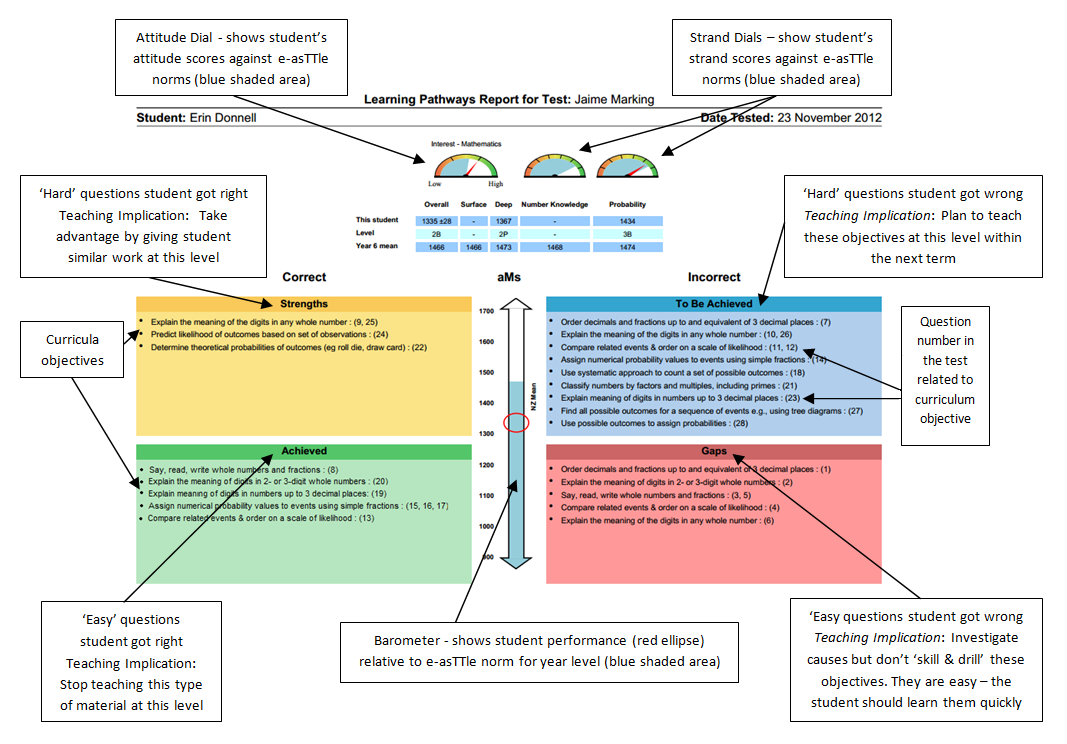At Mission Heights Junior College we use e-asTTle tests at the beginning, middle and end of the year to help us gain an insight into the numeracy and literacy abilities of our students. This data in turn helps us to personalise and cater for the diverse learning needs of our students, it is also used to help us measure student progress.
At the completion of each test each student has an ‘Individual Learning Pathway’ report that is generated for them. This report allows them and us as their teachers to identify their strengths and weaknesses. This is the report that your child will share with you in their Student Led Conference.

The report is divided up into four quadrants:
- Achieved (Yellow) – questions that, given the student’s overall e-asTTle score (in the appropriate curriculum area), should have been answered correctly and were.
- Strengths (Green)– questions that were expected to be answered incorrectly, given the student’s overall e-asTTle score, but were answered correctly. These questions are more difficult than his/her overall ability. However for reading, it is possible for a student to have correctly guessed the answer to questions that would normally be outside their ability range. While such responses will be excluded from the student’s level calculation, the questions will still display in the Strengths box.
- Gaps (Red) – questions that, given the student’s overall e-asTTle score should have been answered correctly but were incorrect. These are questions that would be expected to be relatively easy for the student. This is an area where teachers will investigate to determine the reason. It may be due to carelessness, skipping questions, illness or not having being taught it yet. As these questions are at a level easier than the student’s overall ability, it is expected that the student should be able to learn this information quickly.
- To Be Achieved (Blue) – questions that were expected to be answered incorrectly, given the student’s overall e-asTTle score, and were answered incorrectly. These questions signify areas that the student has yet to achieve and in which it is expected they will require more teaching and learning of strategies to achieve in this/these areas moving forward.
It is possible for the same objective to be listed in multiple quadrants, because the questions relating to a single objective may be of varying curriculum levels.
A question may appear more than once in the same quadrant. This is because a question may have more than one objective associated with it.
More information about the ILP reports can be found here.
We have recently developed and are trialling a new tool which will see students identify the area of most concern in the ‘To Be Achieved (Blue)’ box of their report and make a goal using strategies to target this area of weakness. We are hoping that by doing this students will have a better understanding of the reports, their own capabilities and take more ownership of their learning between tests by making and revisiting goals around their needs.
At the completion of the test an overall score is generated for each student, from these scores we are able to identify if students are ‘well below’, ‘below’, ‘at’ or ‘above’ where they should be for their cohort nationally. This information is outlaid in the ‘MHJC Traffic Lighting’ for reading and maths and is used by teachers to personalise the learning of students with level appropriate texts and tasks. This differentiation and personalisation of learning is important in order to help students make positive shifts towards where they need to be to meet cohort expectation or to extend them and provide them with the necessary challenge needed if they are working above level.

